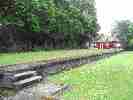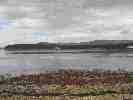|
The Far North Line from Inverness to Wick and Thurso is an important strategic rail link and has recently secured additional freight traffic. Between Tain and Golspie, the route loops inland to serve Lairg. Dornoch was formerly linked to the main rail network by a light railway constructed from a junction at “The Mound”, which shared an existing road causeway across Loch Fleet and then followed the southern shore of the loch and coast to a terminus in the town. The light railway was opened in 1902, but services were withdrawn in 1960. The original station in Dornoch still exists (Figure 3.1), but the track bed and land immediately north are now occupied by a small industrial estate. The remainder of the route is still relatively unobstructed. A substantial section is used as a footpath.
Following a decision by the Scottish Office in 1984 to provide a bridge for the A9 Trunk road at Tain, British Rail produced a proposal in a very short time for a rail link parallel to the A9 from Tain to Golspie. The scheme was predicted to provide a 30 - 45 minute reduction in the journey time from Inverness to Wick and Thurso. The railway proposal, however, failed to secure Government funding and did not proceed. The A9 road bridge was built, but as a stand alone highway project (figure 2.2).
There has been a continued campaign since to provide the link and the link is supported in the Highland Structure Plan. The Far North Railway provides social benefits to a rural area including Caithness and Orkney with high unemployment and low earnings. There is an ongoing need to improve the rail service to deliver those benefits. North of Tain, the line has not enjoyed the growth evident on the Inverness to Kyle route and partly this could be explained by the poor journey times. The scheme proposed by British Rail would have left the existing railway and shared the Dornoch Firth Bridge with the A9 road and then followed a north easterly alignment passing to the north of Dornoch before joining the corridor of the former light railway. The route crossed all three roads leading into Dornoch using level crossings and the proposed station was to be sited approximately 1 mile from the town centre. Rather than following the original railway to The Mound, the link would have left the former corridor to cross Loch Fleet to the west of Littleferry on a new causeway and bridges (Figure 3.3) and joined the existing railway at Golspie.
Railtrack evaluated the proposal for a chord line
from west to north at Georgemas Junction, with a new station at Halkirk,
prior to that company going into administration. |
|
| Forward To Methodology | |


